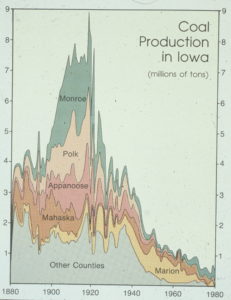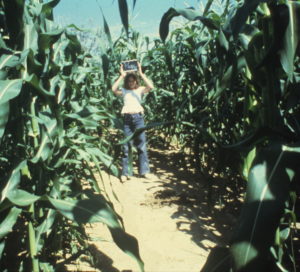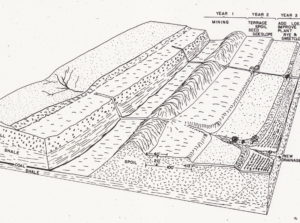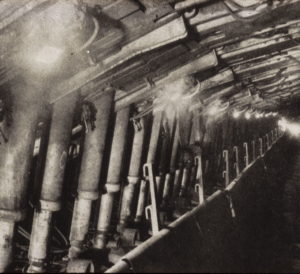King Coal Leaves Iowa
Continuing last week’s history of Iowa coal:

Stripping for coal in Illinois. The wheeled conveyor belt in the background removes the dirt and dumps it atop the crushed rock removed by the big shovel.
The many scattered pockets of coal, which served small-scale mining so well in the 1800s, began to work against it as mining became more mechanized and more pricy to start up. By contrast, in Illinois the geology was quite different. The Illinois number nine coal seam runs as a nearly continuous slab beneath much of a dozen counties. Big machines could strip the dirt and rock separately and put the dirt back on top where it belonged.

Iowa coal production.
In the WWII era, diesel fuel began to replace coal, and Iowa’s favored location for westbound and eastbound trains gradually became irrelevant. Thus King Coal’s tarnished career began to slip quite early in Iowa.
In the late 1960s, environmental awareness began to creep into Iowa, and included questions about all the abandoned mines washing acid and sediment into our streams and rivers.
In the early 1970s, graduate student Todd Ririe and I ran field experiments to determine how much dirt cover would be necessary to support vegetation atop acid mine spoils. The answer: for 100 bushel corn, it was five feet. For permanent erosion control grassland, as hay, pasture, or prairie, four feet was mostly adequate if the right species were selected.

100 bushel corn on the test plot.
We went on to design a system for mining Iowa coal and building agricultural terraces at the same time.

Our mine plan.
But King Coal exited Iowa completely a few years later. Part of his demise was the introduction of longwall mining in Illinois, in which the roof of an underground mine was held up by a long row of hydraulic jacks. These were all slid forward slowly and gradually, removing all the coal and creating a controlled collapse of the roof behind the jacks. The end product was cheaper coal with less environmental damage.

Longwall mining in Illinois.
The other stake in his heart was EPA regulations limiting the amount of sulfur allowed to go up the chimney of a power plant, attempting to limit acid rain downwind. This mostly originates from the mineral pyrite in the coal, and all Iowa coal has a lot of pyrite, one mine was producing coal that was 11% pyrite.
The last active coal mine in Iowa closed sometime around 1980 and I haven’t heard of any new ones opening since. The old mines continue to erode and bleed acid because they support so little vegetation, and Iowa has no substantial regulations controlling erosion.
Much more slowly, King Coal is fading in other states, driven mostly by economics, and very little by the environmental mess of mining, acid rain, carbon dioxide, methane, acid waters, and underground fires. Most Iowa power plants still burn coal, now mined in other states. We need to keep reducing our electrical consumption from coal and keep shifting to solar and wind.
Tags: coal, energy consumption, habitat degradation, Lon Drake

